What your footy team was once called and how it got its name
We are the mighty fighting ... Mayblooms? Your footy club probably didn't start off with the name you know it by now. Here's how AFL team names have changed over the years.
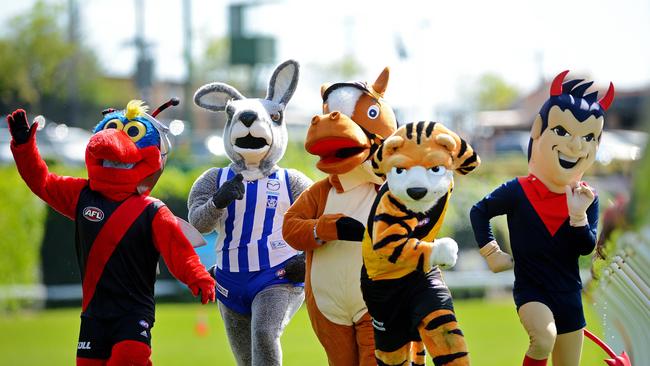
AFL
Don't miss out on the headlines from AFL. Followed categories will be added to My News.
Which AFL club was once nicknamed the Saltwater Lads? How about the Fuchsias, and the Penguins?
Most Aussie footy clubs have changed their names multiple times and been given a string of nicknames by fans.
Take a look back at how your team’s name has changed over the decades.
North Melbourne Kangaroos — Shinboners, Bluebirds
The club formed in 1869 and was widely known as the ‘Shinboners’ for much of its early history.
The precise origins of the nickname are unknown, but it may have had something to do with the club’s reputation for targeting the shinbones of opposition players; its 19th-century abattoir-worker origins; or to do with local butchers who showed their support for the team by dressing up beef leg-bones in the club colours.
By 1926, the club was known as the ‘Blue Birds’ but this nickname didn’t last.
Phones Tobin, the North president from 1953—56, oversaw the club adopting the Kangaroos emblem in 1954 as he found the image of a shinbone unsavoury and wanted the club to have a mascot it could show with pride.
In selecting a new name, he wanted something characteristically Australian, and unsurprisingly selected a kangaroo.
The club has had several kangaroo mascots — including a brown, cuddly looking one that, in more recent times, morphed into an angry looking grey kangaroo.
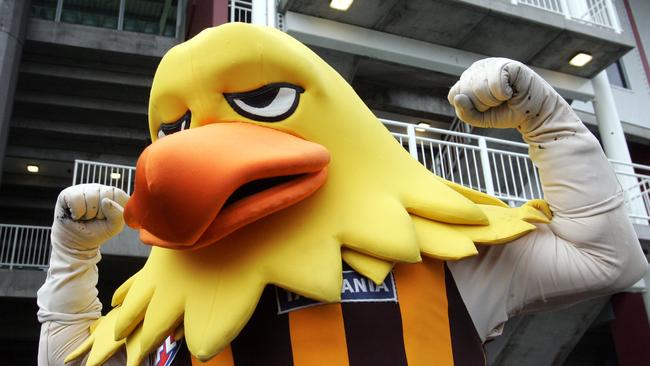
Hawthorn Hawks — The Mayblooms
When Hawthorn entered the VFL in 1925 their nickname was The Mayblooms — after a flower that grew in the Hawthorn area.
Then in round 2, 1943 when Hawthorn played Essendon, Hawthorn’s coach Roy Cazaly told the players that in future they would be known as the Hawks instead of the Mayblooms — allegedly on the advice of his daughter.
“I expect players to live up to the name being ready to fight hard and carry the ball away with pace and dash to the goal,” Cazaly said.
The Hawks’s mascot is Hudson “Hawka” Knights, a caricature of a sleepy looking hawk.
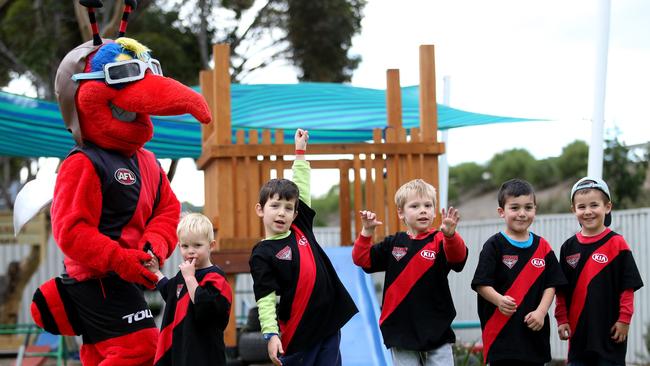
Essendon Bombers — Same Olds, Mosquito Fleet
Essendon was forced to move grounds in 1881 because the City of Essendon mayor considered the Essendon Cricket Ground “to be suitable only for the gentleman’s game of cricket”, and the team moved to East Melbourne.
The club became known by the nickname “the Same Old Essendon” after they moved grounds, and the nickname first appeared in print in the local North Melbourne Advertiser in 1889, and ended up gaining wide use, often as the “Same Olds”.
‘Dons’ was used for most of 20th century, but it wasn’t until WWII when Essendon’s proximity to the wartime airport caused the nickname of The Bombers to be adopted.
The club’s mascot is Skeeta Reynolds, named after Dick Reynolds. He is a mosquito and was created in honour of the team’s back-to-back premiership sides in the 1920s who were known as the “Mosquito Fleet”.
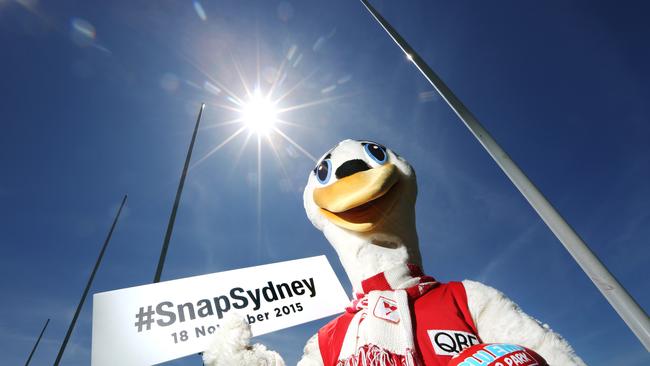
Sydney Swans (formerly South Melbourne) — Bloodstained Angels, Southerners
When the club started in 1874, it adopted the name South Melbourne Football Club.
Nicknamed the Southerners, the team was more colourfully known as The Bloods, in reference to the bright red sash on their white jumpers (the sash was replaced with a red V in 1932).
They were also called the Bloodstained Angels.
In 1933, the Swans name was suggested by a Herald and Weekly Times artist, inspired by the number of Western Australians in the team (the black swan being the state emblem of Western Australia), and was formally adopted by the club before the 1934 season.
The name stuck, in part due to the club’s association with Albert Park Lake, also known for its swans.
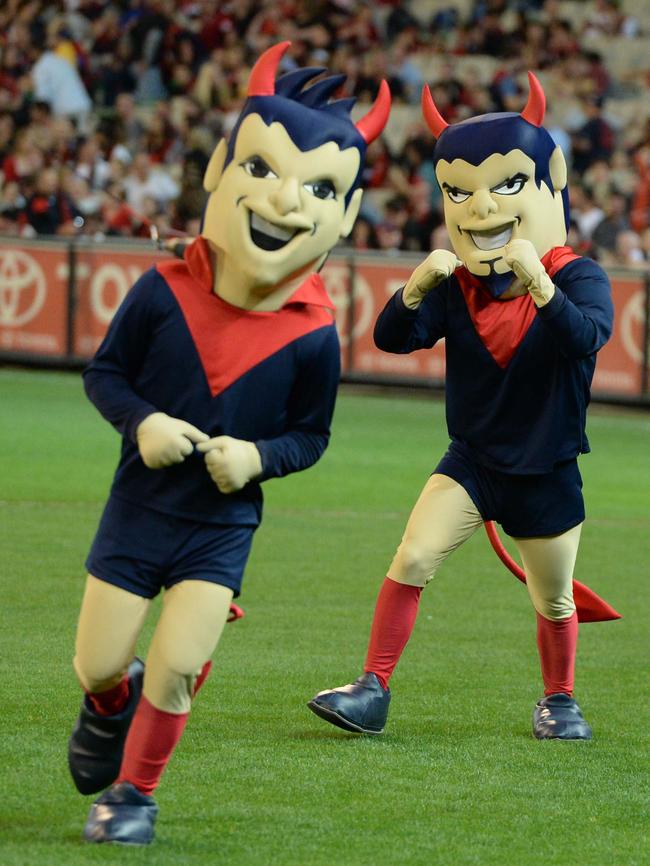
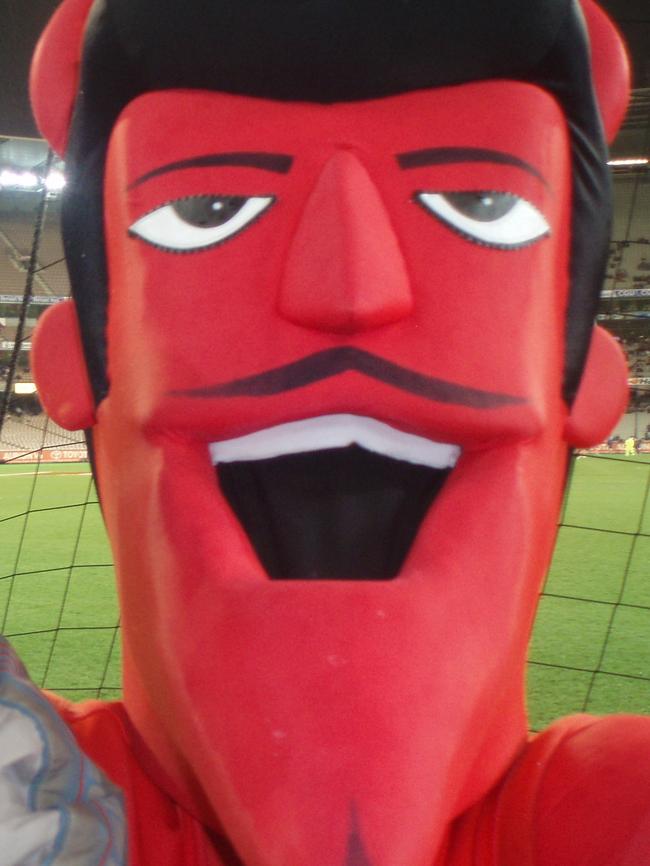
Melbourne Demons — Fuchsias, Invincible Whites, Redlegs
Melbourne first had the nickname ‘Invincible Whites’ in the early days of the club because players wore white and in the 1870s they wore red football socks, and were dubbed the Redlegs by fans.
In 1877, the club became a foundation member of the Victorian Football Association and became known as the Fuchsias until 1933.
Then-Melbourne coach Frank ‘Checker’ Hughes, pulled the team aside at a break in play to blast them with: “You are playing like a lot of flowers! Lift up your heads and play like demons!”
The name stuck and the team adopted the demon as their mascot.
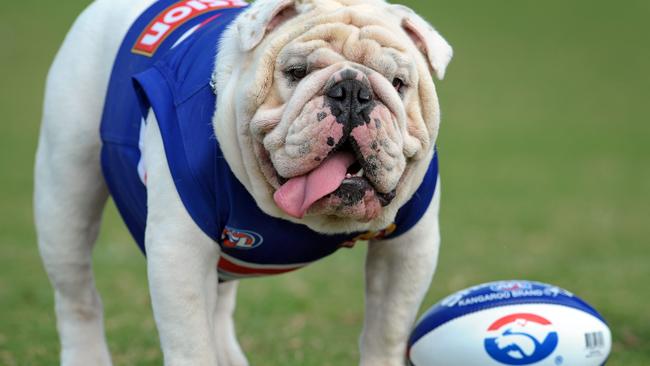
Western Bulldogs — Imperials, Tricolours, Scray
The club was called the Footscray Football Club and early nicknames were The Imperials and Tricolours.
They were also referred to as Scray, Saltwater Lads, Bone-mill Fellows, and the men from the land of the boulders.
In 1920, Johnny Craddock inspired the term ‘bulldog tenacity’ after he led the side to VFA premiership glory.
The team changed their name to the Bulldogs in 1938 and started using the bulldog in its emblem.
In October 1996, the club began to play under its current name of the Western Bulldogs, changing from its original name of the Footscray Football Club.
The real life mascot for the Western Bulldogs, is a British bulldog named ‘Sid’, used to appear at all of the Western Bulldogs home games wearing the club colours. He passed away in 2018.
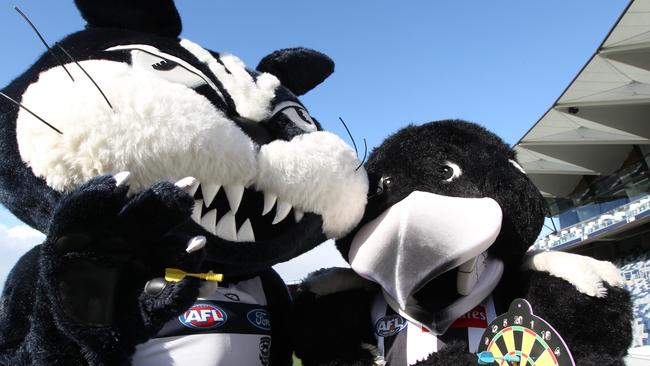
Geelong Cats — Pivotonians, Pivots, Seagulls
The team was originally referred to as the ‘Pivotonians’ or ‘Pivots’. Which apparently came about because Geelong was regarded as a centre or ‘pivot’ of trade.
The clubs colours are said to represent the white seagulls and blue water of Corio Bay — and they were known as the seagulls for a short time — but Williamstown beat them to the name.
The club’s nickname, The Cats, was first used in 1923 after a run of losses prompted a local cartoonist to suggest the club needed a black cat to bring it good luck.
By 1925 ‘Carn the Cats’ was already being mixed in with ‘Carn the Pivots,’ and they eventually adopted The Cats.
Geelong’s mascot is a menacing looking cat bearing its teeth.
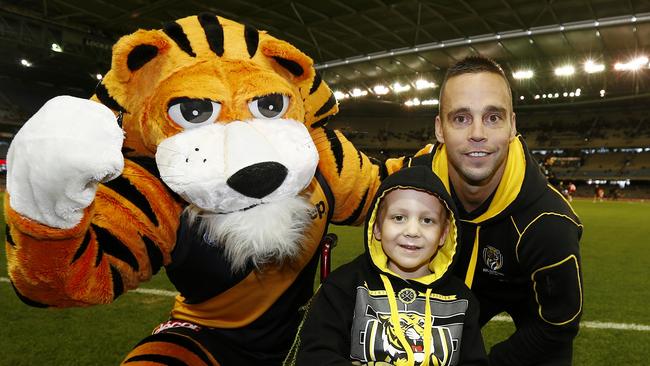
Richmond Tigers — Yellow and Black Angels, Wasps
The club was formed in 1885, and the Richmond players opted for yellow and black striped caps, the same as the cricket club.
The team was variously called the Richmondites, Yellow and Black Angels, Wasps or, most commonly, the Tigers — which they formally adopted.
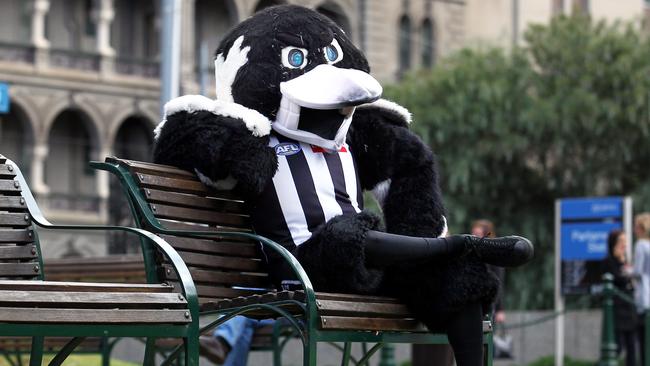
Collingwood Magpies
According to club records, a supporter had suggested the black and white colours after being impressed with the magpie on the South Australian coat of arms.
Large numbers of magpies also frequented the banks of the Yarra near Victoria Park, and so this nickname was picked up.
‘Floreat Pica’ the club motto, can be translated as: ‘May the Magpie prosper.’

St Kilda Saints — Seagulls, Panthers, Penguins
The prefix has always made Saints the logical nickname for the team, however the seagull was often associated with the club in early times, and there was an attempt to name it the Panthers in the 40s and the Penguins in the 50s.
But the Saints name stuck.
The team’s mascot is a superhero caricature wearing a mask and a halo.

Brisbane Lions (formerly Fitzroy) — Bears, Roys, Roy Boys, Gorrillas
The Brisbane Bears merged with the Fitzroy’s Lions in 1996 and joined the national competition in 1997.
The lion was selected over the bear, presumably because the Fitzroy Football Club was formed in 1883, while the Bears only started playing in 1987.
Back in the day, Fitzroy was often referred to as the Roys or Roy Boys, and in the search for an identity, Gorillas was used from before World War II until about 1952.
It was then dropped as opposition supporters took to calling the players apes.
As Roys wasn’t considered to be strong name, the club opted for a Lion emblem that has been used from 1957 onwards.
Carlton Blues, Butchers
Carlton’s official nickname is the Blues, since the addition of navy blue to the playing uniform in 1871.
The club is also called the Dark Blues or Navy Blues and other colloquial nicknames include Bluebaggers or Baggers.
Prior to 1871, the club was known informally as The Butchers, as they wore chamois coloured uniforms (which is the colour of butcher’s paper).
After World War II, the club briefly considered changing its nickname to the Cockatoos, but this never formally adopted — although newspaper cartoons were printed around that time that depicted the team as a Cockatoo.
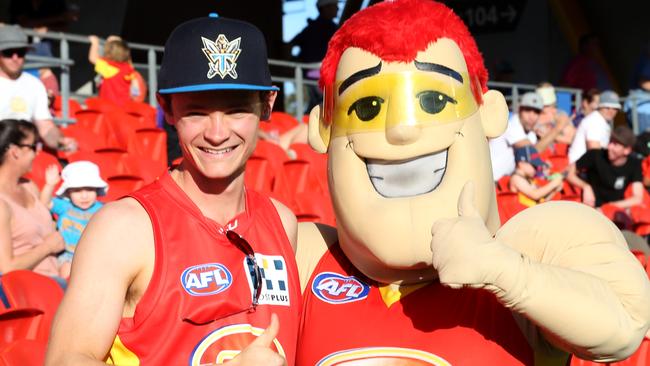
Gold Coast Suns
In 2010, the Gold Coast Football Club revealed its nickname, team colours and team song ahead of its AFL debut in 2011.
When you think about the Gold Coast, you think about the sun — and hence the name of the team.
The club’s mascot is Sunny Ray — a smiling, ginger muscle man in a tight Lycra body suit.
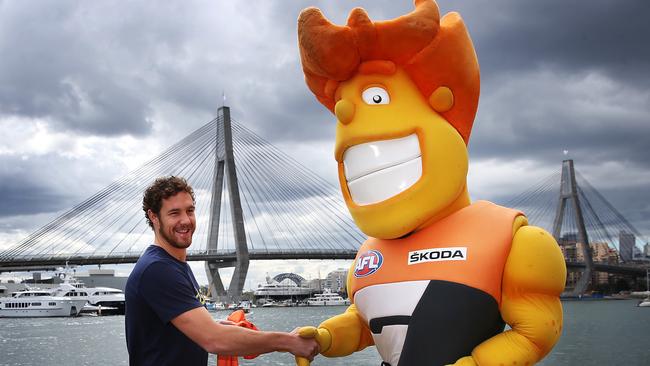
Greater Western Sydney Giants
They are one of the newest teams in the league, making their season debut in 2012, they were named the Giants in 2010.
The team motto is Think Big. Live Big. Play Big. And what’s bigger and more threatening than a Giant?
The team’s mascot is strangely similar to the Gold Coast Suns — a grinning, flame haired muscle man in Lycra. Perhaps the two newest teams in the league got together and decided on a bit of national ginger pride.
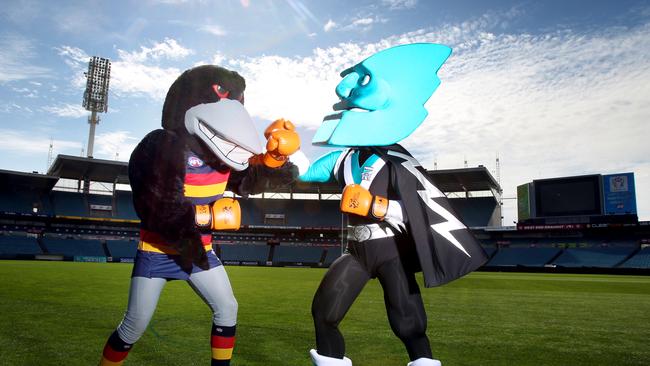
Port Adelaide Power — Magpies
Although Port Adelaide was an Australian Rules Football team since the 1870s, they only obtained an AFL licence in 1994 and had to wait until 1997 to enter the national league.
Port Adelaide were always known as the Magpies and their uniforms had black and white stripes — but unfortunately both of those were taken by Collingwood.
Port Adelaide was requested by the AFL to find a new nickname and logo to avoid a clash. However, after the unsuccessful 1990 bid to join the league, Collingwood successfully lobbied the AFL to force Port Adelaide to change not only its logo and nickname but also its guernsey and colours.
The new moniker, Power, was announced live from the Adelaide Entertainment Centre in 1995.
The name needs no explanation — we’re here and we’re as powerful as lightning.
The teams mascot is Tommy “Thunda” Power. A rather scary looking dude with a lightening bolt for a head.
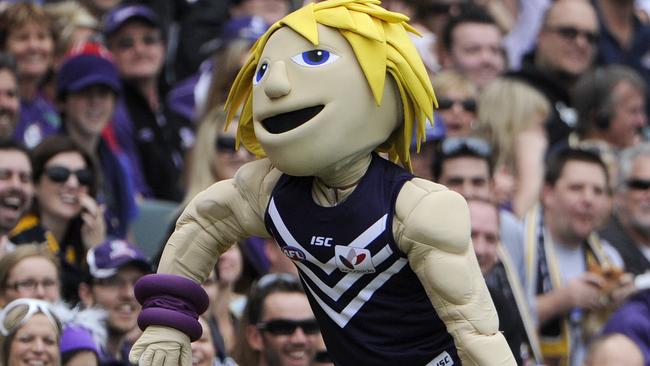
Fremantle Dockers
Since the formation of the West Australian Football Association in 1885, Fremantle has become synonymous with Australian rules football.
For generations, fierce rivalries between East, South and North Fremantle would draw record crowds and produce champion players.
In 1994, when the AFL was to launch a second West Australian AFL team, the rich football history and culture of Fremantle made it the perfect fit.
The issue of the nickname was open to many suggestions, but eventually the tag of Dockers was chosen due to Fremantle’s long association with wharfies.
The team’s mascot is Johnny “The Doc” Docker. He’s not a burly dock worker but a blonde surfer dude.

Adelaide Crows
The Crows were formed in 1990 by the SANFL and played their first season in 1991.
There is not a lot of information on why the team is called the Crows — although it possibly comes from a historical reference to people from Adelaide being called Crow Eaters.
“In 1851 my father and uncle travelled overland to the Bendigo diggings. On their arrival they were accosted with the words “crow eaters” ... A short time before they arrived a party of South Australians had arrived in a very hard-up state ... While crossing the 90-mile desert they run out of tucker and were forced to shoot crows for food ... On relating their experience they were dubbed crow eaters. The term was afterwards applied to every new arrival from the central State,” South Australian Register, March 15, 1927.
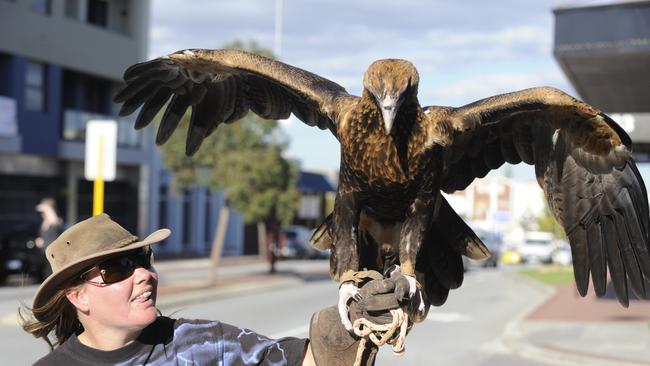
West Coast Eagles
The WA team was granted entry to the VFL in 1986 to broaden the Victorian competition and played its first game the following season.
The Wedge-tailed eagle is a strong, majestic Australian predator — which is presumably why it was selected as the emblem when the club was formed.
In recent years, the club has had a real-life wedge-tailed eagle named Auzzie that performs tricks before matches. They also have Rick “the Rock” Eagle, a giant smiling eagle mascot.
The eagle logo on the player’s jumpers faces right, supposedly symbolically eyeing off its rivals to the east.
READ MORE:
12 PEOPLE WHO TRIED A FOOTY CAREER BEFORE BECOMING FAMOUS FOR SOMETHING COMPLETELY DIFFERENT
WEIRD AND WACKY AFL RULES FROM 1850-2000
AFL RULES YOU NEVER KNEW EXISTED
FOOTY CHRISTMAS SHOPPING GUIDE
THE DEFINITIVE RANKING OF AFL CLUB SONGS
Originally published as What your footy team was once called and how it got its name
